Synthesis of Metal Nanoparticles via Pulicaria undulata and an Evaluation of Their Antimicrobial, Antioxidant, and Cytotoxic Activities
Abstract
:1. Introduction
2. Materials and Methods
2.1. Plant Material and Extraction Process
2.2. Synthesis of Metal Nanoparticles
2.3. Characterization of Metal Nanoparticles
2.4. Gas Chromatography-Mass Spectroscopic Analysis (GC-MS)
2.5. Phytochemical Analysis
2.5.1. Total Tannin Contents
2.5.2. Total Phenolic Contents
2.5.3. Total Flavonoid Contents
2.6. Biological Procedures
2.6.1. Estimation of Antioxidant Activity
2.6.2. Assessment of the Antibacterial Activity
2.6.3. Cytotoxicity Assay
3. Results and Discussion
3.1. GC-MS Spectroscopy
3.2. Characterization of the Metal/Metal Oxide Nanoparticles
3.2.1. Transmission Electron Microscope (TEM)
3.2.2. Zeta Potential Analysis
3.2.3. UV–Visible Spectrophotometer
3.2.4. FT-IR Measurements
3.3. Phytochemical Analysis
3.4. Biological Evaluation
3.4.1. DPPH Antioxidant Activity
3.4.2. Cytotoxic Activity
3.4.3. Antimicrobial Activity
4. Conclusions
Supplementary Materials
Author Contributions
Funding
Data Availability Statement
Acknowledgments
Conflicts of Interest
References
- Elshamy, A.I.; Farrag, A.R.H.; Ayoub, I.M.; Mahdy, K.A.; Taher, R.F.; Gendy, A.E.-N.G.E.; Mohamed, T.A.; Al-Rejaie, S.S.; Ei-Amier, Y.A.; Abd-EIGawad, A.M. UPLC-qTOF-MS phytochemical profile and antiulcer potential of Cyperus conglomeratus Rottb. alcoholic extract. Molecules 2020, 25, 4234. [Google Scholar] [CrossRef] [PubMed]
- El-Amier, Y.; Abdelghany, A.; Abed Zaid, A. Green synthesis and antimicrobial activity of Senecio glaucus-mediated silver nanoparticles. Res. J. Pharm. Biol. Chem. Sci. 2014, 5, 631–642. [Google Scholar]
- Boukhatem, M.N.; Setzer, W.N. Aromatic herbs, medicinal plant-derived essential oils, and phytochemical extracts as potential therapies for coronaviruses: Future perspectives. Plants 2020, 9, 800. [Google Scholar] [CrossRef] [PubMed]
- Mohammed, A.B.; Yagi, S.; Tzanova, T.; Schohn, H.; Abdelgadir, H.; Stefanucci, A.; Mollica, A.; Mahomoodally, M.F.; Adlan, T.A.; Zengin, G. Chemical profile, antiproliferative, antioxidant and enzyme inhibition activities of Ocimum basilicum L. and Pulicaria undulata (L.) CA Mey. grown in Sudan. South Afr. J. Bot. 2020, 132, 403–409. [Google Scholar] [CrossRef]
- Al-hamoud, K.; Shaik, M.R.; Khan, M.; Alkhathlan, H.Z.; Adil, S.F.; Kuniyil, M.; Assal, M.E.; Al-Warthan, A.; Siddiqui, M.R.H.; Tahir, M.N.; et al. Pulicaria undulata extract-mediated eco-friendly preparation of TiO2 nanoparticles for photocatalytic degradation of methylene blue and methyl orange. ACS Omega 2022, 7, 4812–4820. [Google Scholar] [CrossRef]
- Mustafa, A.M.; Eldahmy, S.I.; Caprioli, G.; Bramucci, M.; Quassinti, L.; Lupidi, G.; Beghelli, D.; Vittori, S.; Maggi, F. Chemical composition and biological activities of the essential oil from Pulicaria undulata (L.) CA Mey. Growing wild in Egypt. Nat. Prod. Res. 2020, 34, 2358–2362. [Google Scholar] [CrossRef]
- Abd-ELGawad, A.M.; Al-Rowaily, S.L.; Assaeed, A.M.; Ei-Amier, Y.A.; El Gendy, A.E.-N.G.; Omer, E.; Al-Dosari, D.H.; Bonanomi, G.; Kassem, H.S.; Elshamy, A.I. Comparative chemical profiles and phytotoxic activity of essential oils of two ecospecies of Pulicaria undulata (L.) CA Mey. Plants 2021, 10, 2366. [Google Scholar] [CrossRef]
- Ali, N.A.A.; Sharopov, F.S.; Alhaj, M.; Hill, G.M.; Porzel, A.; Arnold, N.; Setzer, W.N.; Schmidt, J.; Wessjohann, L. Chemical composition and biological activity of essential oil from Pulicaria undulata from Yemen. Nat. Prod. Commun. 2012, 7, 257–260. [Google Scholar] [CrossRef]
- Tesfaye, M.; Gonfa, Y.; Tadesse, G.; Temesgen, T.; Periyasamy, S. Green synthesis of silver nanoparticles using Vernonia amygdalina plant extract and its antimicrobial activities. Heliyon 2023, 9, e17356. [Google Scholar] [CrossRef]
- Elhady, S.S.; Abdelhameed, R.F.; Zekry, S.H.; Ibrahim, A.K.; Habib, E.S.; Darwish, K.M.; Hazem, R.M.; Mohammad, K.A.; Hassanean, H.A.; Ahmed, S.A. VEGFR-mediated cytotoxic activity of Pulicaria undulata isolated metabolites: A biological evaluation and in silico study. Life 2021, 11, 759. [Google Scholar] [CrossRef]
- Emam, M.A.; Khattab, H.I.; Hegazy, M.G.A. Assessment of anticancer activity of Pulicaria undulata on hepatocellular carcinoma HepG2 cell line. Tumor Biology 2019, 41, 10. [Google Scholar] [CrossRef] [PubMed]
- Mohammed, H.A.; Al-Omar, M.S.; Khan, R.A.; Mohammed, S.A.; Qureshi, K.A.; Abbas, M.M.; Al Rugaie, O.; Abd-Elmoniem, E.; Ahmad, A.M.; Kandil, Y.I. Chemical profile, antioxidant, antimicrobial, and anticancer activities of the water-ethanol extract of Pulicaria undulata growing in the oasis of central Saudi Arabian desert. Plants 2021, 10, 1811. [Google Scholar] [CrossRef] [PubMed]
- Foudah, A.I.; Alam, A.; Soliman, G.A.; Salkini, M.A.; Ahmed, E.I.; Yusufoglu, H.S. Pharmacognostical, antioxidant and antimicrobial studies of aerial part of Pulicaria crispa (Family: Asteraceae). Bull. Environ. Pharmacol. Life Sci. 2015, 4, 19–27. [Google Scholar]
- Elshiekh, Y.H.; Mona, A. Gas chromatography–mass spectrometry analysis of Pulicaria crispa (whole plant) petroleum ether extracts. Am. J. Res. Commun. 2015, 3, 58–67. [Google Scholar]
- Damyeh, M.S.; Niakousari, M. Ohmic hydrodistillation, an accelerated energy-saver green process in the extraction of Pulicaria undulata essential oil. Ind. Crops Prod. 2017, 98, 100–107. [Google Scholar] [CrossRef]
- Paramasivam, G.; Palem, V.V.; Sundaram, T.; Sundaram, V.; Kishore, S.C.; Bellucci, S. Nanomaterials: Synthesis and applications in theranostics. Nanomaterials 2021, 11, 3228. [Google Scholar] [CrossRef]
- Baig, N.; Kammakakam, I.; Falath, W. Nanomaterials: A review of synthesis methods, properties, recent progress, and challenges. Mater. Adv. 2021, 2, 1821–1871. [Google Scholar] [CrossRef]
- Karunakaran, G.; Sudha, K.G.; Ali, S.; Cho, E.-B. Biosynthesis of nanoparticles from various biological sources and its biomedical applications. Molecules 2023, 28, 4527. [Google Scholar] [CrossRef]
- Ramakrishna, M.; Rajesh Babu, D.; Gengan, R.M.; Chandra, S.; Nageswara Rao, G. Green synthesis of gold nanoparticles using marine algae and evaluation of their catalytic activity. J. Nanostruct. Chem. 2016, 6, 1–13. [Google Scholar] [CrossRef]
- Rana, A.; Yadav, K.; Jagadevan, S. A comprehensive review on green synthesis of nature-inspired metal nanoparticles: Mechanism, application and toxicity. J. Clean. Prod. 2020, 272, 122880. [Google Scholar] [CrossRef]
- Jadoun, S.; Arif, R.; Jangid, N.K.; Meena, R.K. Green synthesis of nanoparticles using plant extracts: A review. Environ. Chem. Lett. 2021, 19, 355–374. [Google Scholar] [CrossRef]
- Dehvari, M.; Ghahghaei, A. The effect of green synthesis silver nanoparticles (AgNPs) from Pulicaria undulata on the amyloid formation in α-lactalbumin and the chaperon action of α-casein. Int. J. Biol. Macromol. 2018, 108, 1128–1139. [Google Scholar] [CrossRef] [PubMed]
- Khan, M.; Al-Hamoud, K.; Liaqat, Z.; Shaik, M.R.; Adil, S.F.; Kuniyil, M.; Alkhathlan, H.Z.; Al-Warthan, A.; Siddiqui, M.R.H.; Mondeshki, M. Synthesis of Au, Ag, and Au–Ag bimetallic nanoparticles using Pulicaria undulata extract and their catalytic activity for the reduction of 4-nitrophenol. Nanomaterials 2020, 10, 1885. [Google Scholar] [CrossRef] [PubMed]
- Azwanida, N. A review on the extraction methods use in medicinal plants, principle, strength and limitation. Med. Aromat. Plants 2015, 4, 2167–2412. [Google Scholar]
- Devasenan, S.; Beevi, N.H.; Jayanthi, S. Synthesis and characterization of copper nanoparticles using leaf extract of Andrographis paniculata and their antimicrobial activities. Int. J. ChemTech Res. 2016, 9, 725–730. [Google Scholar]
- Otunola, G.A.; Afolayan, A.J.; Ajayi, E.O.; Odeyemi, S.W. Characterization, antibacterial and antioxidant properties of silver nanoparticles synthesized from aqueous extracts of Allium sativum, Zingiber officinale, and Capsicum frutescens. Pharmacogn. Mag. 2017, 13, S201. [Google Scholar] [CrossRef]
- Bhattacharjee, S. DLS and zeta potential–what they are and what they are not? J. Control. Release 2016, 235, 337–351. [Google Scholar] [CrossRef]
- Honary, S.; Zahir, F. Effect of zeta potential on the properties of nano-drug delivery systems-a review. Trop. J. Pharm. Res. 2013, 12, 265–273. [Google Scholar]
- Burlingame, B. Wild nutrition. J. Food Compos. Anal. 2000, 2, 99–100. [Google Scholar] [CrossRef]
- Issa, N.K.; Abdul Jabar, R.; Hammo, Y.; Kamal, I. Antioxidant activity of apple peels bioactive molecules extractives. J. Sci. Technol. 2016, 6, 76–88. [Google Scholar]
- Zhishen, J.; Mengcheng, T.; Jianming, W. The determination of flavonoid contents in mulberry and their scavenging effects on superoxide radicals. Food Chem. 1999, 64, 555–559. [Google Scholar] [CrossRef]
- Kitts, D.D.; Wijewickreme, A.N.; Hu, C. Antioxidant properties of a North American ginseng extract. Mol. Cell. Biochem. 2000, 203, 1–10. [Google Scholar] [CrossRef] [PubMed]
- Parejo, I.; Codina, C.; Petrakis, C.; Kefalas, P. Evaluation of scavenging activity assessed by Co (II)/EDTA-induced luminol chemiluminescence and DPPH·(2, 2-diphenyl-1-picrylhydrazyl) free radical assay. J. Pharmacol. Toxicol. Methods 2000, 44, 507–512. [Google Scholar] [CrossRef] [PubMed]
- Boyanova, L.; Gergova, G.; Nikolov, R.; Derejian, S.; Lazarova, E.; Katsarov, N.; Mitov, I.; Krastev, Z. Activity of Bulgarian propolis against 94 Helicobacter pylori strains in vitro by agar-well diffusion, agar dilution and disc diffusion methods. J. Med. Microbiol. 2005, 54, 481–483. [Google Scholar] [CrossRef] [PubMed]
- Opoku, A.; Geheeb-Keller, M.; Lin, J.; Terblanche, S.; Hutchings, A.; Chuturgoon, A.; Pillay, D. Preliminary screening of some traditional Zulu medicinal plants for antineoplastic activities versus the HepG2 cell line. Phytother. Res. 2000, 14, 534–537. [Google Scholar] [CrossRef] [PubMed]
- Abdallah, H.M.; Mohamed, G.A.; Ibrahim, S.R.; Asfour, H.Z.; Khayat, M.T. Undulaterpene A: A new triterpene fatty acid ester from: Pulicaria undulata. Pharmacogn. Mag. 2019, 15, 671–674. [Google Scholar] [CrossRef]
- Al-Hajj, N.Q.M.; Wang, H.; Gasmalla, M.A.; Ma, C.; Thabit, R.; Rahman, M.R.T.; Tang, Y. Chemical composition and antioxidant activity of the essential oil of Pulicaria inuloides. J. Food Nutr. Res. 2014, 2, 221–227. [Google Scholar] [CrossRef]
- Mansour, H.F.M. Larvicidal Activity of Essential Oils from Nigella sativa L. and Pulicaria undulata (L.) CA Mey. against the Mosquito Vectors Anopheles gambiae and Culex quinquefasciatus. Ph.D. Thesis, University of Khartoum, Khartoum, Sudan, 2020. [Google Scholar]
- Behera, A.; Awasthi, S. Anticancer, antimicrobial and hemolytic assessment of zinc oxide nanoparticles synthesized from Lagerstroemia indica. BioNanoScience 2021, 11, 1030–1048. [Google Scholar] [CrossRef]
- Zeinalipour-Yazdi, C.D.; Willock, D.J.; Thomas, L.; Wilson, K.; Lee, A.F. CO adsorption over Pd nanoparticles: A general framework for IR simulations on nanoparticles. Surf. Sci. 2016, 646, 210–220. [Google Scholar] [CrossRef]
- Sharifi-Rad, M.; Pohl, P.; Epifano, F. Phytofabrication of silver nanoparticles (AgNPs) with pharmaceutical capabilities using Otostegia persica (burm.) boiss. leaf extract. Nanomaterials 2021, 11, 1045. [Google Scholar] [CrossRef]
- Assaeed, A.; Elshamy, A.; El Gendy, A.E.-N.; Dar, B.; Al-Rowaily, S.; Abd-ElGawad, A. Sesquiterpenes-rich essential oil from above ground parts of Pulicaria somalensis exhibited antioxidant activity and allelopathic effect on weeds. Agronomy 2020, 10, 399. [Google Scholar] [CrossRef]
- Sharifi-Rad, M.; Pohl, P. Synthesis of biogenic silver nanoparticles (Agcl-NPs) using a Pulicaria vulgaris gaertn. aerial part extract and their application as antibacterial, antifungal and antioxidant agents. Nanomaterials 2020, 10, 638. [Google Scholar] [CrossRef] [PubMed]
- Tavakoli, R.; Mohadjerani, M.; Hosseinzadeh, R.; Tajbakhsh, M.; Naqinezhad, A. Essential-oil and fatty-acid composition, and antioxidant activity of extracts of Ficaria kochii. Chem. Biodivers. 2012, 9, 2732–2741. [Google Scholar] [CrossRef]
- Salama, S.A.; Al-Faifi, Z.E.; El-Amier, Y.A. Chemical composition of Reichardia tingitana methanolic extract and its potential antioxidant, antimicrobial, cytotoxic and larvicidal activity. Plants 2022, 11, 2028. [Google Scholar] [CrossRef] [PubMed]
- Zubair Dhabian, S.; Sabeeh Jasim, R. Antioxidant, cytotoxic, and antihemolytic activity of greenly synthesized selenium nanoparticles using Elettaria cardamomum Extract. J. Nanostruct. 2023, 13, 76–85. [Google Scholar]
- Dhabian, S.Z.; Jasim, R.S. Anticancer and antioxidant activity of the greenly synthesized zinc nanoparticles composites using aqueous extract of Withania somnifera plant. Egypt. J. Chem. 2021, 64, 5561–5574. [Google Scholar] [CrossRef]
- Khorrami, S.; Zarrabi, A.; Khaleghi, M.; Danaei, M.; Mozafari, M. Selective cytotoxicity of green synthesized silver nanoparticles against the MCF-7 tumor cell line and their enhanced antioxidant and antimicrobial properties. Int. J. Nanomed. 2018, 13, 8013. [Google Scholar] [CrossRef]
- Salama, S.A.; Al-Faifi, Z.E.; Masood, M.F.; El-Amier, Y.A. Investigation and biological assessment of Rumex vesicarius L. extract: Characterization of the chemical components and antioxidant, antimicrobial, cytotoxic, and anti-dengue vector activity. Molecules 2022, 27, 3177. [Google Scholar] [CrossRef]
- Shirzadi-Ahodashti, M.; Mortazavi-Derazkola, S.; Ebrahimzadeh, M.A. Biosynthesis of noble metal nanoparticles using crataegus monogyna leaf extract (CML@X-NPs, X= Ag, Au): Antibacterial and cytotoxic activities against breast and gastric cancer cell lines. Surf. Interfaces 2020, 21, 100697. [Google Scholar] [CrossRef]
- Hussain, A.; Lakhan, M.N.; Hanan, A.; Soomro, I.A.; Ahmed, M.; Bibi, F.; Zehra, I. Recent progress on green synthesis of selenium nanoparticles—A review. Mater. Today Sustain. 2023, 23, 100420. [Google Scholar] [CrossRef]
- Menon, S.; Shrudhi Devi, K.S.; Agarwal, H.; Shanmugam, V.K. Efficacy of Biogenic Selenium Nanoparticles from an Extract of Ginger towards Evaluation on Anti-Microbial and Anti-Oxidant Activities. Colloid Interface Sci. Commun. 2019, 29, 1–8. [Google Scholar] [CrossRef]
- Sarkar, R.D.; Lahkar, P.; Kalita, M.C. Glycosmis pentaphylla (Retz.) DC leaf extract mediated synthesis of selenium nanoparticle and investigation of its antibacterial activity against urinary tract pathogens. Bioresour. Technol. Rep. 2022, 17, 100894. [Google Scholar] [CrossRef]
- Vinu, D.; Govindaraju, K.; Vasantharaja, R.; Amreen Nisa, S.; Kannan, M.; Vijai Anand, K. Biogenic zinc oxide, copper oxide and selenium nanoparticles: Preparation, characterization and their anti-bacterial activity against Vibrio parahaemolyticus. J. Nanostruct. Chem. 2021, 11, 271–286. [Google Scholar] [CrossRef]
- El-Zayat, M.M.; Eraqi, M.M.; Alrefai, H.; El-Khateeb, A.Y.; Ibrahim, M.A.; Aljohani, H.M.; Aljohani, M.M.; Elshaer, M.M. The antimicrobial, antioxidant, and anticancer activity of greenly synthesized selenium and zinc composite nanoparticles using Ephedra aphylla extract. Biomolecules 2021, 11, 470. [Google Scholar] [CrossRef] [PubMed]
- Chen, Q.; Dharmaraj, T.; Cai, P.C.; Burgener, E.B.; Haddock, N.L.; Spakowitz, A.J.; Bollyky, P.L. Bacteriophage and bacterial susceptibility, resistance, and tolerance to antibiotics. Pharmaceutics 2022, 14, 1425. [Google Scholar] [CrossRef]
- Akter, M.; Sikder, M.T.; Rahman, M.M.; Ullah, A.A.; Hossain, K.F.B.; Banik, S.; Hosokawa, T.; Saito, T.; Kurasaki, M. A systematic review on silver nanoparticles-induced cytotoxicity: Physicochemical properties and perspectives. J. Adv. Res. 2018, 9, 1–16. [Google Scholar] [CrossRef] [PubMed]
- Shaukat, U.; Ahemad, S.; Wang, M.; Khan, S.I.; Ali, Z.; Tousif, M.I.; Abdallah, H.H.; Khan, I.A.; Saleem, M.; Mahomoodally, M.F. Phenolic contents, chemical profiling, in silico and in vitro anti-inflammatory and anticancer properties of Alnus nitida (Spach) Endl. S. Afr. J. Bot. 2021, 138, 148–155. [Google Scholar] [CrossRef]

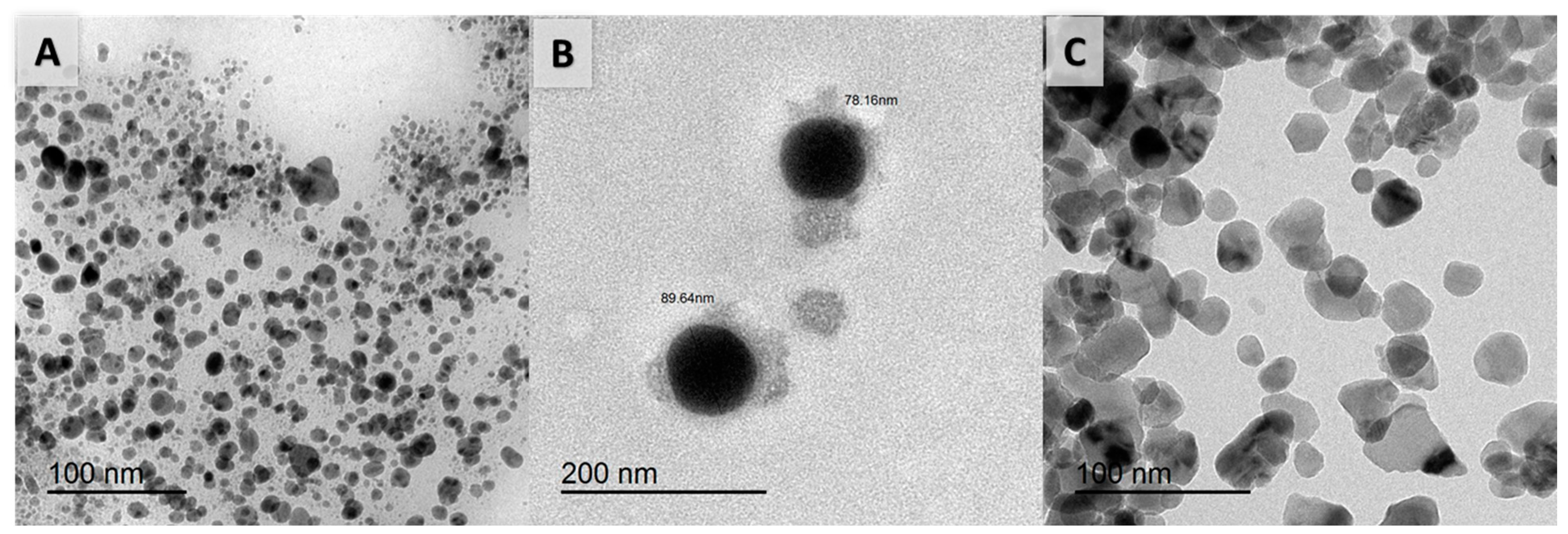
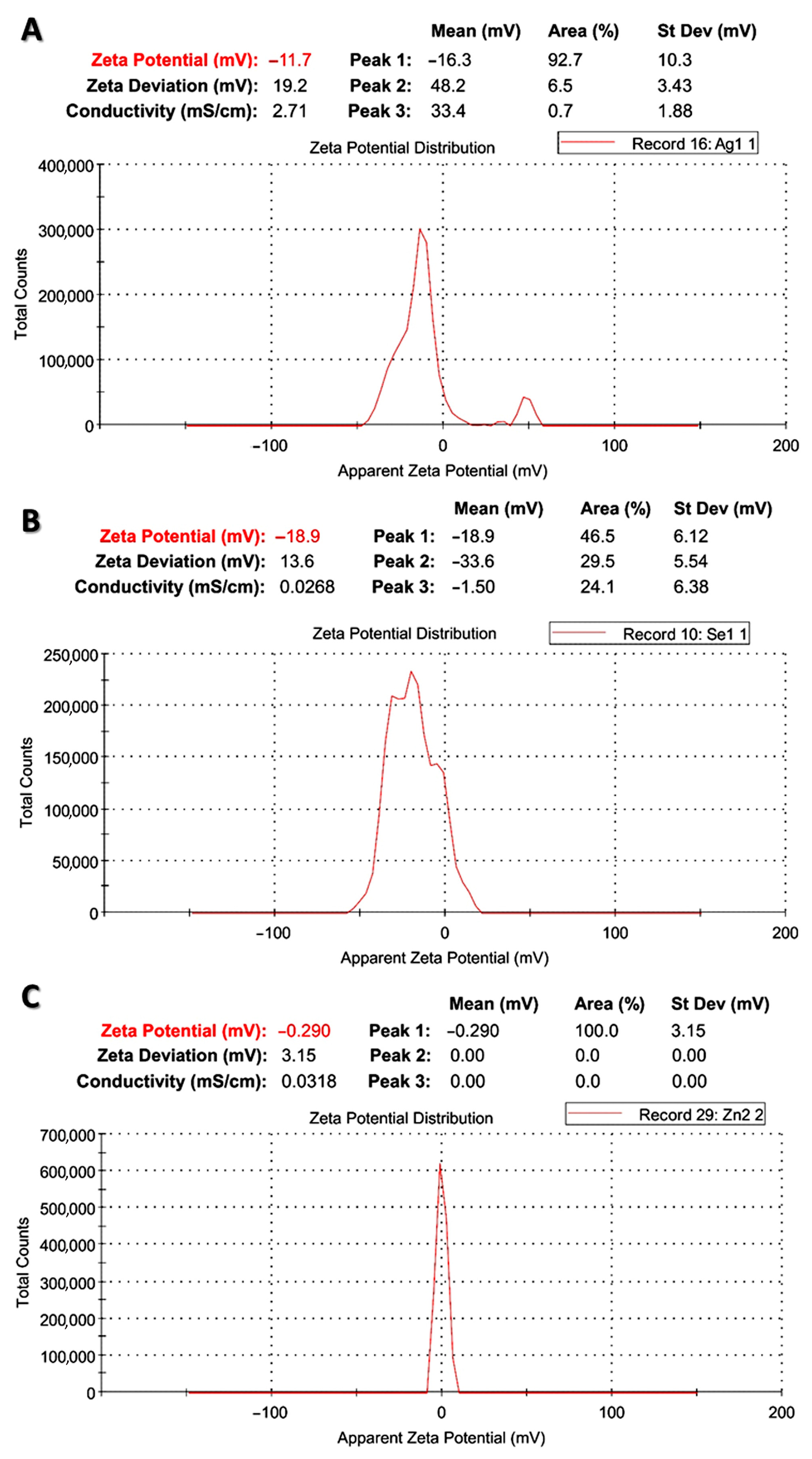
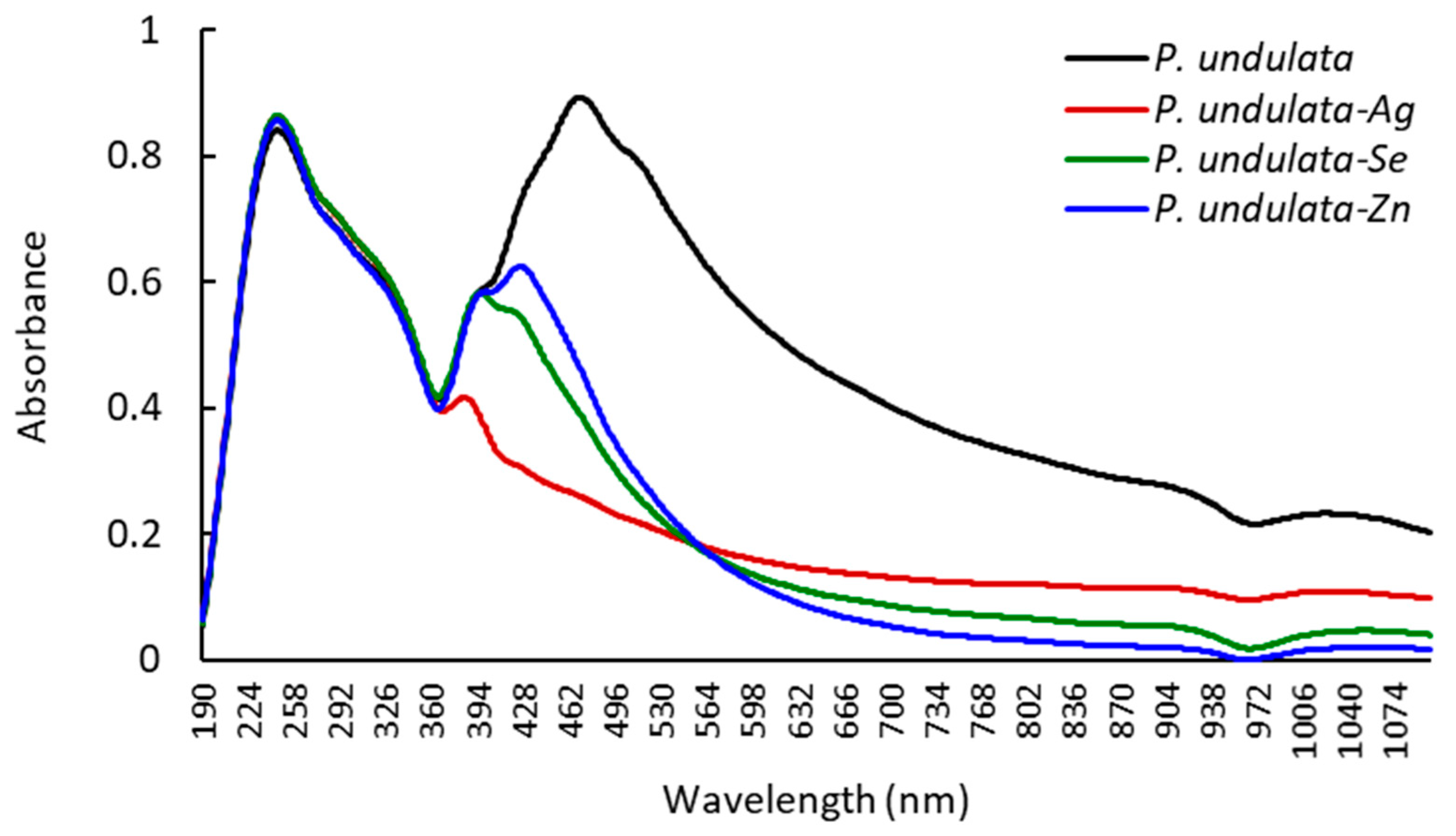
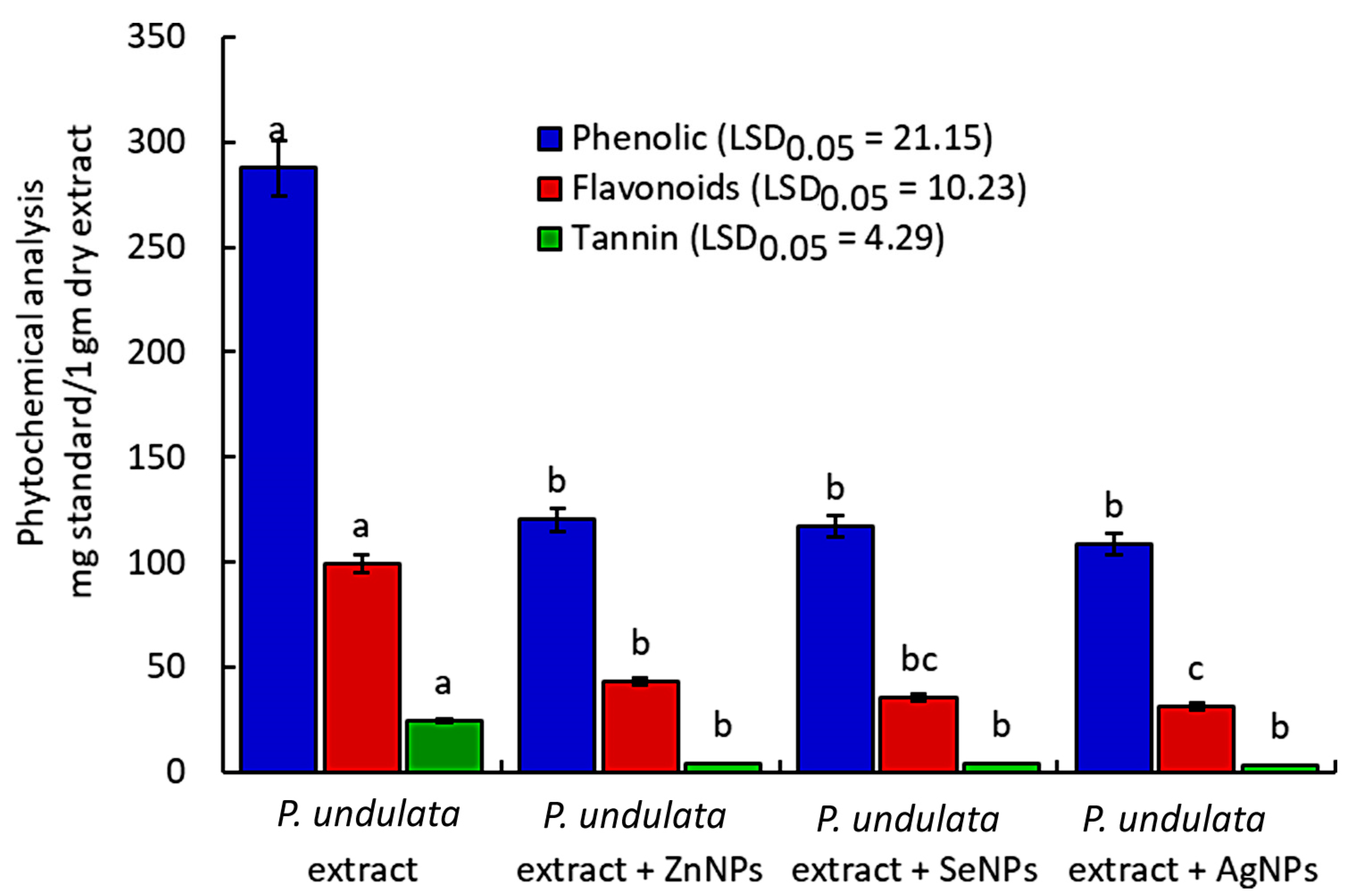
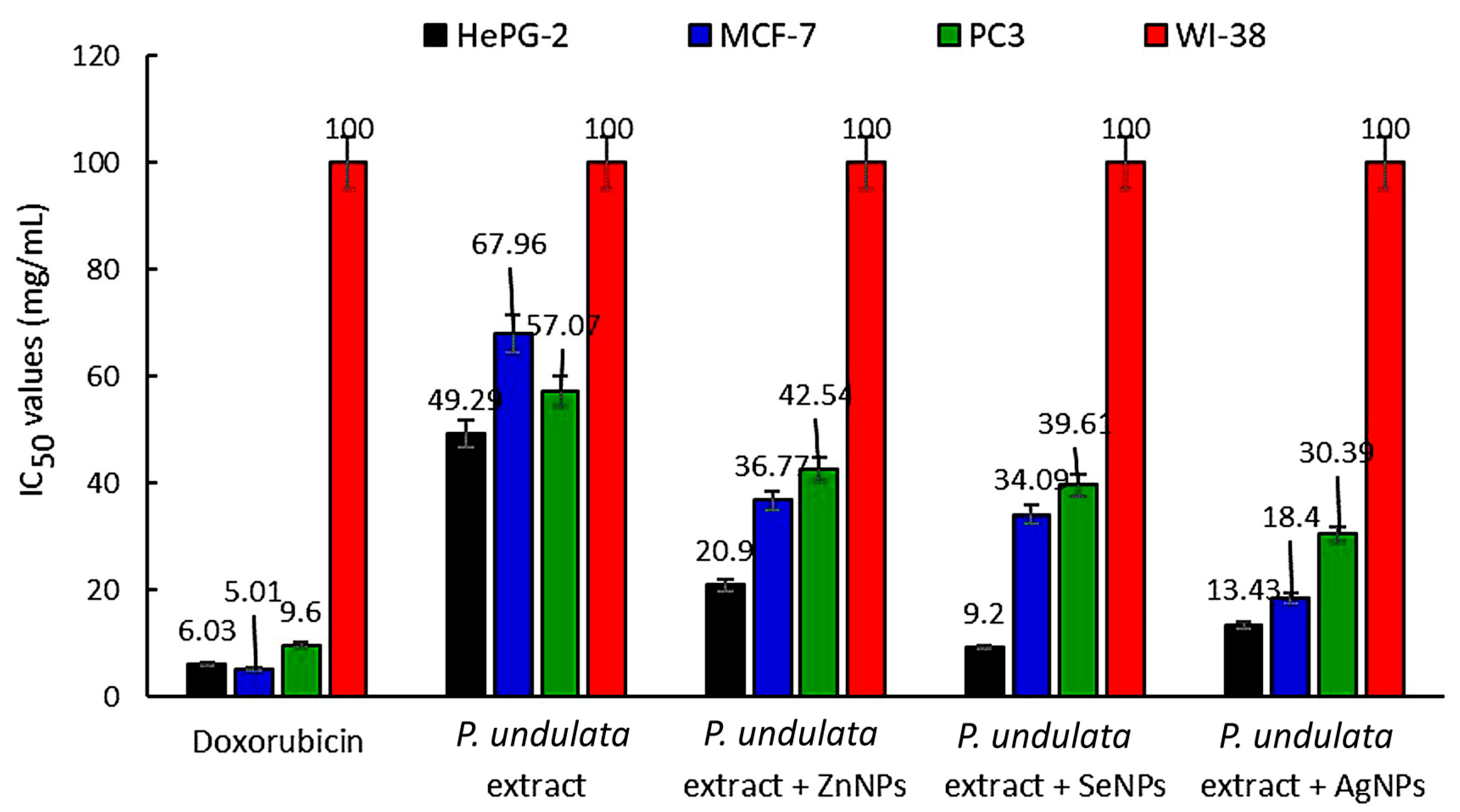
| Entry | Volatile Components | Classification | RT a (min) | M.Wt. b | M.Fw. c | Area (%) |
|---|---|---|---|---|---|---|
| Hydrocarbons | ||||||
| 1 | (2E,6E)-3,7-dimethylnona-2,6-dienal | Hydrocarbon | 5.65 | 166.26 | C11H18O | 1.57 |
| 2 | 3,6-dimethyloctan-2-one | Hydrocarbon | 7.44 | 156.27 | C10H20O | 1.53 |
| 3 | (Z)-2-butylocta-2,7-dien-1-ol | Hydrocarbon | 11.51 | 182.31 | C12H22O | 1.08 |
| 4 | tetradeca-1,13-dien-3-one | Hydrocarbon | 11.58 | 208.35 | C14H24O | 1.89 |
| 5 | (1R,4R,6R,10S)-4,12,12-trimethyl-9-methylene-5-oxatricyclo[8.2.0.04,6]dodecane | Hydrocarbon | 14.47 | 220.36 | C15H24O | 6.20 |
| 6 | (1S,5R,9R)-10,10-dimethyl-2,6-dimethylenebicyclo[7.2.0]undecan-5-ol | Hydrocarbon | 15.58 | 220.36 | C15H24O | 5.93 |
| 7 | (2E,15Z)-14-methyloctadeca-2,15-dien-1-ol | Hydrocarbon | 18.79 | 280.50 | C19H36O | 2.61 |
| 8 | 6,10,14-trimethylpentadecan-2-one | Hydrocarbon | 19.27 | 268.49 | C18H36O | 12.77 |
| 9 | Retinal “Vitamin A” | Hydrocarbon | 20.25 | 284 | C20H28O | 1.03 |
| 10 | 3-ethyl-5-(2-ethylbutyl)octadecane | Hydrocarbon | 33.47 | 366.72 | C26H54 | 0.89 |
| 11 | Heptatriacontan-1-ol | Hydrocarbon | 35.73 | 537.01 | C37H76O | 2.69 |
| Fatty acids and esters | ||||||
| 12 | Ethyl (9Z,12Z)-octadeca-9,12-dienoate | Ester of fatty acid | 12.04 | 308.51 | C20H36O2 | 1.51 |
| 13 | (Z)-7-methyltetradec-1-en-1-yl acetate | Ester of fatty acid | 12.46 | 268.44 | C17H32O2 | 1.69 |
| 14 | Methyl (5Z,8Z,11Z,14Z)-icosa-5,8,11,14-tetraenoate | Ester of fatty acid | 16.29 | 318.50 | C21H34O2 | 3.33 |
| 15 | Ethyl (9Z,12Z)-octadeca-9,12-dienoate | Ester of fatty acid | 16.40 | 308.51 | C20H36O2 | 1.92 |
| 16 | Methyl 14-methylpentadecanoate | Ester of fatty acid | 20.62 | 270.46 | C17H34O2 | 2.75 |
| 17 | Palmitic acid | Fatty acid | 21.70 | 256.43 | C16H32O2 | 11.08 |
| 18 | Methyl (7E,10E)-octadeca-7,10-dienoate | Ester of fatty acid | 23.25 | 294.48 | C19H34O2 | 1.07 |
| 19 | Methyl oleate | Ester of fatty acid | 23.35 | 296.50 | C19H36O2 | 23.97 |
| 20 | Methyl 16-methylheptadecanoate | Ester of fatty acid | 23.76 | 298.51 | C19H38O2 | 1.08 |
| 21 | Oleic acid | Fatty acid | 24.33 | 282.47 | C18H34O2 | 4.25 |
| 22 | (2-phenyl-1,3-dioxolan-4-yl)methyl (E)-octadec-9-enoate | Ester of fatty acid | 35.25 | 444.66 | C28H44O4 | 1.26 |
| 23 | 2,2,8,8-tetramethyl-3,7-dioxa-2,8-disilanonan-5-yl oleate | Ester of fatty acid | 35.41 | 500.91 | C27H56O4Si2 | 5.56 |
| Terpenes | ||||||
| 24 | (Z)-1-methyl-4-(6-methylhepta-2,5-dien-2-yl)-7-oxabicyclo[4.1.0]heptane | Sesquiterpene | 16.01 | 220.36 | C15H24O | 1.31 |
| Steroids | ||||||
| 25 | Stigmast-5-en-3-ol | Steroid | 34.46 | 414.72 | C29H50O | 1.01 |
| Total | 99.98 | |||||
| P. undulata Extract | Ag NPs | SeO2 NPs | ZnO NPs | Appearance | Functional Group |
|---|---|---|---|---|---|
| 3414 | 3420 * | 3420 | 3418 | Sharp | O-H stretching |
| 2933 | 2931 | 2927 | - | Medium | C-H stretching |
| 1619 | 1620 | 1628 | 1628 | Weak, Strong | C-O stretching |
| 1387 | 1385 | 1385 | 1402 | Medium | C-H bending |
| 1270 | 1263 | - | 1283 | Medium | C-O-H |
| 1037 | 1077 | 1050 | 1082 | Medium | C-N stretching |
| 601 | 602 | 605 | 693 | Strong | C-H bending |
| Sample | Concentrations (mg/mL) | Scavenging Activity (%) |
|---|---|---|
| P. undulata extract | 0.034 | 61.95 ± 2.82 A |
| 0.017 | 36.92 ± 1.68 B | |
| 0.008 | 16.55 ± 0.75 C | |
| 0.004 | 11.03 ± 0.50 D | |
| IC50 | 0.025 | |
| LSD | 2.83 *** | |
| F-value | 706.94 | |
| P. undulata extract + ZnNPs | 0.207 | 83.81 ± 3.81 A |
| 0.104 | 73.11 ± 3.32 B | |
| 0.052 | 42.04 ± 1.91 C | |
| 0.026 | 24.93 ± 1.13 D | |
| IC50 | 0.062 | |
| LSD | 4.18 *** | |
| F-value | 452.18 | |
| P. undulata extract + SeNPs | 0.358 | 85.38 ± 3.88 A |
| 0.179 | 57.05 ± 2.59 B | |
| 0.089 | 38.64 ± 1.76 C | |
| 0.045 | 31.85 ± 1.45 D | |
| IC50 | 0.125 | |
| LSD | 3.95 *** | |
| F-value | 390.28 | |
| P. undulata extract + AgNPs | 0.122 | 71.72 ± 3.26 A |
| 0.061 | 48.79 ± 2.22 B | |
| 0.031 | 19.84 ± 0.90 C | |
| 0.015 | 13.67 ± 0.62 D | |
| IC50 | 0.068 | |
| LSD | 3.02 *** | |
| F-value | 846.81 | |
| Zinc-Ascorbic acid | 0.013 | 54.56 ± 2.48 A |
| 0.007 | 27.75 ± 1.26 B | |
| 0.003 | 13.4 ± 0.61 C | |
| 0.002 | 2.681 ± 0.12 D | |
| IC50 | 0.012 | |
| LSD | 2.54 *** | |
| F-value | 828.21 | |
| Ascorbic acid | 0.062 | 85.19 ± 3.87 A |
| 0.031 | 62.07 ± 2.82 B | |
| 0.016 | 40.74 ± 1.85 C | |
| 0.008 | 27.41 ± 1.25 D | |
| IC50 | 0.0222 | |
| LSD | 4.96 *** | |
| F-value | 276.55 |
| Samples | Conc. (mg/mL) | % Inhibition | |||
|---|---|---|---|---|---|
| HePG-2 | MCF-7 | PC3 | WI-38 | ||
| Doxorubicin | 100 | 94.20 | 94.31 | 92.4 | 10.11 |
| 50 | 89.51 | 90.21 | 82.6 | 8.75 | |
| 25 | 86.32 | 86.10 | 76.3 | 6.55 | |
| 12.5 | 69.50 | 74.70 | 59.2 | 3.78 | |
| 6.25 | 52.33 | 56.91 | 42.7 | 1.87 | |
| 3.125 | 40.10 | 41.62 | 26.4 | 0.67 | |
| 1.56 | 26.6 | 28.51 | 23.9 | 0.02 | |
| P. undulata extract | 100 | 64.5 | 56.70 | 64.5 | 9.22 |
| 50 | 54.13 | 45.40 | 50.3 | 7.70 | |
| 25 | 42.45 | 35.31 | 38.1 | 5.66 | |
| 12.5 | 31.43 | 24.10 | 28.4 | 3.50 | |
| 6.25 | 20.15 | 18.60 | 21.3 | 1.65 | |
| 3.125 | 9.47 | 11.32 | 17.9 | 0.33 | |
| 1.56 | 5.72 | 8.74 | 9.34 | 0.00 | |
| P. undulata extract + ZnNPs | 100 | 72.54 | 66.65 | 64.9 | 10.12 |
| 50 | 63.04 | 56.91 | 54.2 | 9.70 | |
| 25 | 56.14 | 46.04 | 40.3 | 7.55 | |
| 12.5 | 45.89 | 33.33 | 32.8 | 6.50 | |
| 6.25 | 36.08 | 16.06 | 24.6 | 5.74 | |
| 3.125 | 24.11 | 20.66 | 21.64 | 3.33 | |
| 1.56 | 2.12 | 0.00 | 0.00 | 2.88 | |
| P. undulata extract + SeNPs | 100 | 80.32 | 69.3 | 66.07 | 12.12 |
| 50 | 70.16 | 61.14 | 57.03 | 10.57 | |
| 25 | 64.34 | 52.01 | 47.86 | 8.35 | |
| 12.5 | 50.60 | 40.77 | 40.33 | 7.85 | |
| 6.25 | 40.20 | 28.16 | 30.55 | 5.63 | |
| 3.125 | 27.40 | 11.56 | 9.34 | 3.34 | |
| 1.56 | 10.81 | 3.22 | 1.35 | 1.82 | |
| P. undulata extract + AgNPs | 100 | 85.6 | 76.90 | 74.11 | 8.40 |
| 50 | 76.73 | 70.10 | 63.20 | 6.80 | |
| 25 | 66.98 | 57.34 | 56.01 | 5.16 | |
| 12.5 | 53.5 | 46.87 | 44.7 | 4.56 | |
| 6.25 | 30.44 | 31.80 | 34.1 | 3.24 | |
| 3.125 | 24.61 | 22.94 | 27.09 | 2.45 | |
| 1.56 | 10.65 | 11.09 | 13.76 | 1.82 | |
| Microbial Species | P. undulata Extract (50 μg/Disk) | P. undulata Extract ± NPs (μg mL−1) | ||||||
|---|---|---|---|---|---|---|---|---|
| SeNPs | ZnNPs | AgNPs | ||||||
| IZ a | MIC b | IZ | MIC | IZ | MIC | IZ | MIC | |
| Gram-negative species | ||||||||
| Escherichia coli | ND c | 0.0 | 38.3 ± 0.93 A | 9 | 18.81 ± 0.44 ABC | 10 | 13.72 ± 0.32 A | 11 |
| Salmonella typhi | ND | 0.0 | 20.16 ± 0.49 C | 11 | 20.32 ± 0.50 A | 9 | 12.61 ± 0.29 AB | 14 |
| Pseudomonas aeruginosa | ND | 0.0 | 14.23 ± 0.34 D | 12 | 15.91 ± 0.37 D | 11 | 12.34 ± 0.30 AB | 15 |
| Klebsiella pneumonia | ND | 0.0 | 21.72 ± 0.51 BC | 10 | 20.58 ± 0.49 A | 9 | 12.55 ± 0.29 AB | 15 |
| Gram-positive species | ||||||||
| Bacillus cereus | ND | 0.0 | 23.08 ± 0.56 BC | 10 | 17.47 ± 0.41 BCD | 8 | 13.48 ± 0.32 A | 12 |
| Staphylococcus aureus | ND | 0.0 | 13.39 ± 0.32 D | 14 | 16.34 ± 0.39 CD | 8 | 12.67 ± 0.31 A | 15 |
| Bacillus subtilis | ND | 0.0 | 22.07 ± 0.54 BC | 10 | 19.27 ± 0.46 AB | 9 | 9.35 ± 0.22 C | 25 |
| Staphylococcus epidermidis | ND | 0.0 | 24.16 ± 0.59 B | 9 | 15.18 ± 0.37 D | 11 | 11.48 ± 0.24 B | 16 |
| Pathogenic yeast | ||||||||
| Candida albicans | ND | 0.0 | 21.05 ± 0.51 BC | 11 | 0.00 E | - | 11.09 ± 0.27 B | 17 |
| LSD0.05 | 3.08 *** | 2.31 *** | 1.38 *** | |||||
Disclaimer/Publisher’s Note: The statements, opinions and data contained in all publications are solely those of the individual author(s) and contributor(s) and not of MDPI and/or the editor(s). MDPI and/or the editor(s) disclaim responsibility for any injury to people or property resulting from any ideas, methods, instructions or products referred to in the content. |
© 2023 by the authors. Licensee MDPI, Basel, Switzerland. This article is an open access article distributed under the terms and conditions of the Creative Commons Attribution (CC BY) license (https://creativecommons.org/licenses/by/4.0/).
Share and Cite
El-Amier, Y.A.; Abduljabbar, B.T.; El-Zayat, M.M.; Sarker, T.C.; Abd-ElGawad, A.M. Synthesis of Metal Nanoparticles via Pulicaria undulata and an Evaluation of Their Antimicrobial, Antioxidant, and Cytotoxic Activities. Chemistry 2023, 5, 2075-2093. https://doi.org/10.3390/chemistry5040141
El-Amier YA, Abduljabbar BT, El-Zayat MM, Sarker TC, Abd-ElGawad AM. Synthesis of Metal Nanoparticles via Pulicaria undulata and an Evaluation of Their Antimicrobial, Antioxidant, and Cytotoxic Activities. Chemistry. 2023; 5(4):2075-2093. https://doi.org/10.3390/chemistry5040141
Chicago/Turabian StyleEl-Amier, Yasser A., Balsam T. Abduljabbar, Mustafa M. El-Zayat, Tushar C. Sarker, and Ahmed M. Abd-ElGawad. 2023. "Synthesis of Metal Nanoparticles via Pulicaria undulata and an Evaluation of Their Antimicrobial, Antioxidant, and Cytotoxic Activities" Chemistry 5, no. 4: 2075-2093. https://doi.org/10.3390/chemistry5040141
APA StyleEl-Amier, Y. A., Abduljabbar, B. T., El-Zayat, M. M., Sarker, T. C., & Abd-ElGawad, A. M. (2023). Synthesis of Metal Nanoparticles via Pulicaria undulata and an Evaluation of Their Antimicrobial, Antioxidant, and Cytotoxic Activities. Chemistry, 5(4), 2075-2093. https://doi.org/10.3390/chemistry5040141








